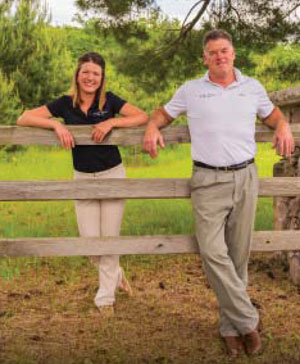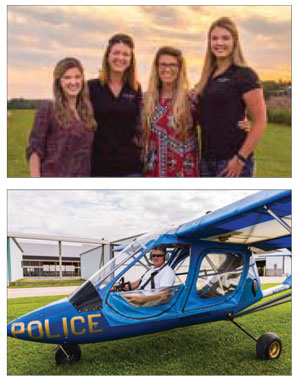Double Up, Power Down

Shared values fast-track family’s transition plan, support dairy expansion
Calf pens surround Zoey Brooks, 24, as she explains the automatic feeders that deliver up to 10 liters of milk per day per calf. Her grandfather, Dodge, leans on an elbow and listens as she explains the technology that has helped the rapidly growing dairy soar past industry benchmarks.
As chief operating officer of Waupaca, Wis.-based Brooks Farms, Zoey represents the sixth generation of dairy producers in her family. She developed the calf facility and manages it daily, beginning at the neonatal unit and ending with the last pen where calves are weaned.
 |
With more than a year of full-time farm management experience, Chief Operating Officer Zoey Brooks of Brooks Farms is a millennial leader learning the ropes from her father, CEO Ron Brooks. |
To Zoey, detail is everything. She oversees calf health, human resources and calf facility management—which is why, on this occasion, the concrete floor of the automatic feeder room draws her attention.
“I’m a clean freak,” Zoey explains. “Right now, the straw on the ground is driving me crazy.”
Young And Driven. The fact Zoey is managing so much at such a young age is a testament to three key factors. First is her business acumen and passion for the farm, which will nearly triple its cow herd this year. It coincides with a market where many are trying to decide whether to go big or risk financial strain. Second is the nationwide transition of farms to a new group of millennial leaders. The third factor is her father, Ron, whose foresight has positioned the operation to one day send 50% of milk to niche products. He has built a strong foundation for his daughter: the expansion is the first project in the farm’s history to require debt.
“The one thing about Ron is there’s nothing under the table,” explains George Twohig, an attorney at Chilton, Wis.-based Twohig Rietbrock Schneider & Halbach S.C., who was instrumental in helping the family craft its succession plan. “Ron and his children have really quality values.”
Successful transition planning and a focus on strategic growth led Ron and Zoey to be recognized as 2016 Top Producer of the Year finalists.
Rapid Transition. When Zoey began talking about returning to Waupaca as a college sophomore, Ron began to position the farm for his daughter and her sisters—Alyssa, 31; Kelsey, 27; and Sydney, 19.
Planning became crucial as Ron went through a divorce.
“We lost almost all of our liquidity,” he says. “I was 56 with no retirement savings, and I was in good shape. You’ve got to reshuffle the deck. I had two options: feel sorry for myself, or take stock and pull up my big-boy pants.”
Their succession plan keeps the operation in control of the active family members, while respecting the involvement of inactive family stakeholders. Ron and his daughters trust that the farm will eventually transfer to a seventh qualified and committed generation that follows.
Stewardship is a word he uses often. “Since the 1850s, our motto has been, ‘You grow it, you build it, you make it your own, you leave it better than you found it.’ Then you give it away,” he says.
Dad and daughters talk business at a weekly meal. Ron plans to transition into retirement over 10 years.
The Brooks operation is built around three LLCs. Brooks Farms Homestead owns all of the land, and the daughters oversee it. Ron has all voting shares. Brooks Farms 1855 owns the cows, equipment and farm checkbook. Brooks Farms Dairy owns the calf facility and construction for the expansion, and Zoey is a 5% stakeholder in the entity.
The New Guy. The structure will place Zoey in an unusual position: Fewer than 6% of farmers are 35 or younger, and just under 14% of principal operators are women.
“To come in and join a team of experienced employees, I felt like the new guy,” Zoey says.
She pushed to purchase a refractometer to measure colostrum quality over the doubts of Ron, who admits he was “dead wrong” for thinking he could look at milk and gauge its value. Now, they grade all colostrum, measure total proteins and refrigerate it quickly.
Their calves have an average daily weight gain of 2.5 lb. to 2.8 lb. per day; the state average is 1.2 lb.
The calf facility opened in September 2015. By that time, Zoey had joined the farm full-time after serving for a year as the state’s “Alice in Dairyland.” The competitively selected public relations position requires nearly 400 appearances throughout the state as a representative of the agriculture industry.
The facility is the first step in an expansion that will grow the farm’s milking herd from 250 to 650 cows, with space to double the herd later.
The new parlor has a herringbone format in a double-16 setup with 32 stalls. There are two milking shifts per day, each five hours long.
Ron and Zoey hope to increase their production from 1,000 lb. of milk per man hour to 6,000 lb. with added milking stalls, improved cow handling and better ventilation.
The Holstein operation prides itself on a low somatic cell count of 50,000—half of the industry’s targeted 100,000 count—a low cost of production at $14.50 per cwt and a $3 to $4 basis advantage per cwt on Class III milk sales.
The family also understands how to tell its story to consumers, says Lynn Thornton, milk quality and herd health reporting manager for Grande Milk Marketing. It began purchasing the farm’s milk in 1982.
Production and financial strengths have supported the dairy’s expansion plans, explains James Dietzler, an ag and commercial loan officer with Premier Community Bank.
“The bank has been impressed with the farm’s ability to maximize profits in volatile times,” he says.
Soaring Together. Flight is part of the Brooks family DNA. Ron’s cousin, Elwyn West, started the tradition as a barnstormer. Dodge purchased a plane in the mid-1980s, and Ron later became a flight instructor and acquired an experimental light sport aircraft.
“Today, I throw a GoPro on the front and we show footage back at team meetings,” Ron explains. The videos capture fields with weeds and downed trees. “You can’t fix it from the air, but you can identify it.”
Nearby, Ron has planted a prairie that features native grasses and wildflowers. In 2020, he anticipates building a cheese cave in the area to age a cotton-wrapped white cheddar. “Our dream is to grow to more than we can supply,” Ron says.
It’s one more example of a father and daughter working together to point their farm and family toward
a future where the only limitation is the sky overhead.
 |
Brooks Farms At A Glance
 |
(TOP) From left, Brooks sisters Kelsey, Zoey, Alyssa and Sydney actively collaborate on farm business. (BOTTOM) The Oshkosh Police Department originally owned Ron’s aircraft. |
Operation: Brooks Farms spans 1,500 owned acres plus 200 rented acres of land for row crops and alfalfa, including a 250-cow dairy that will expand to 650 cows this winter. The operation uses cover crops and manages PACE conservation land that will never be developed for residential, commercial or industrial use per state law.
Family: Ron Brooks is CEO of the operation. His daughter Zoey is chief operating officer. Ron’s father, Dodge, is retired but still works on the farm, while Ron’s daughters Alyssa, Kelsey and Sydney meet weekly with Ron and Zoey to discuss the business. Ron’s passions include woodworking and barefoot water skiing, a sport in which his family competes nationally.
Community: Brooks Farms hosts numerous tours and events such as its local FFA chapter’s “Farmfest” and Pheasants Forever’s “No Child Left Indoors” conservation hunt. It sponsors events and awards at the Waupaca County Fair and is involved in the youth market animal sale.
Technology: A personal experimental light sport aircraft enables Ron to fly over fields and capture video of problem spots in fields. At the dairy, technology includes a refractometer for colostrum grading; a positive pressure ventilation system for barns; and RFID-enabled automatic feeding machines. The operation is moving to no-till using RTK and swath control.







